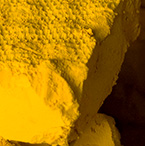Deep Yellow (DYL) - The Uranium Company In Acquisition Mode

Matthew Gordon spoke with John Borshoff, Managing Director of Deep Yellow Ltd. (ASX:DYL) to discuss the company’s recent activities.
Deep Yellow Limited is advancing a dual-pillar growth strategy to establish a multi-mine, 5Mlbs-10Mlbs per annum, low-cost uranium producer. The company’s strategy is focused on organic growth through the development of the existing asset base in Namibia with a Definitive Feasibility Study (DFS) in progress on the Tumas Project and inorganic growth through targeted M&A (Mergers and Acquisitions).
Matt Gordon caught up with John Borshoff, Managing Director and CEO, Deep Yellow. Mr. Borshoff is an experienced mining executive and geologist with more than 40 years of experience in the uranium industry.
At the start of his career, he spent 17 years as a senior geologist and manager of the Australian activities of German uranium miner Uranerz. Following the withdrawal of Uranerz from Australia in 1993, Mr. Borshoff founded Paladin Energy Ltd. He built the company from a junior explorer into a multi-mine uranium producer with a global asset base and valuation of more than $5Bn at its peak. Mr. Borshoff is recognized as a global uranium industry expert and has a vast international network across the uranium and nuclear industries, as well as the mining investment market. His educational credentials include a Bachelor of Science (Geology) degree from the University of Western Australia. He is a Fellow of both the Australian Institute of Company Directors and the Australasian Institute of Mining and Metallurgy. He is a member of the Uranium Forum with the Minerals Council of Australia (where he also served as a former Board member) and sits on the Council of the Namibian Chamber of Mines.
Company Overview
Deep Yellow Limited is aspiring to become a tier-one uranium producer. The company was founded in 1985 and is headquartered in Australia. Reptile Mineral Resources and Exploration Pty Ltd, Superior Uranium Pty. Ltd, Shiyela Iron (Pty) Ltd, Inca Mining (Pty) Ltd, Reptile Uranium Namibia Pty Ltd, Trs Mining Namibia (Pty) Ltd, Deep Yellow Namibia (Pty) Ltd, Nova Energy (Namibia) (Pty) Ltd, and Omahola Uranium (Pty) Ltd, are the company’s subsidiaries. It is listed on the Australian Stock Exchange (ASX: DYL), the OTC Markets (OTCQX: DYLLF), and the Namibian Stock Exchange (NSX: DYL).

Deep Yellow has assets in Namibia. Over the past 5 years, the company has had a 2-pronged growth strategy that includes advancing the value of the existing projects through organic growth and a strategy to include sector consolidation in order to achieve inorganic growth. The company has achieved considerable success in both strategies so far.
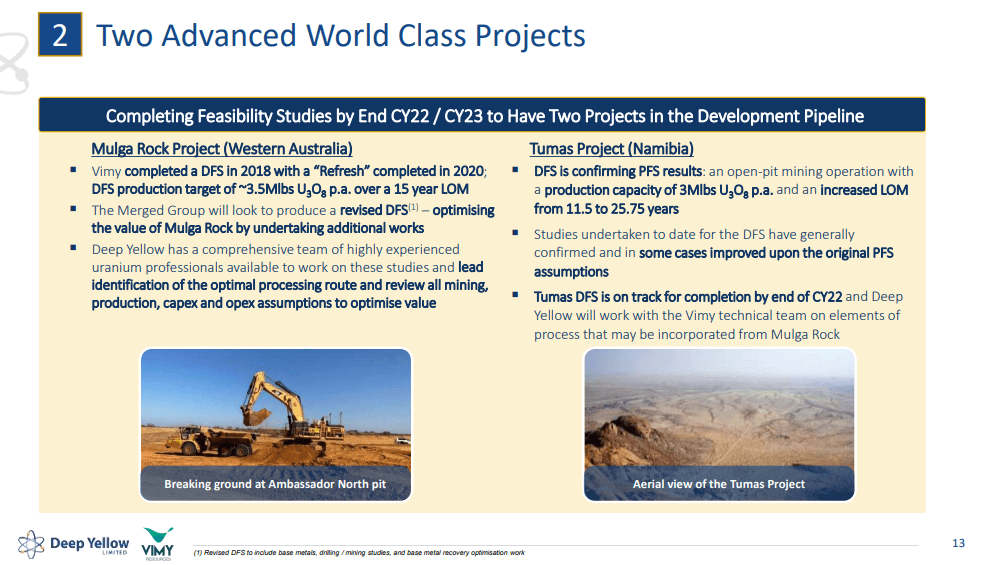
Vimy Resources Merger
Deep Yellow agreed to merge with Vimy Resources in an all-stock deal worth $492M. This merger is expected to create a new global uranium player on a large scale with global uranium mineral resource inventories of 389Mlbs.
On 31st March 2022, Deep Yellow announced a merger with Vimy Resources, a junior mining company with 2 assets in Australia, namely the Mulga Rock Project and the Alligator River Project. Notably, Mulga Rock has a 90Mlbs resource, out of which 60Mlbs-70Mlbs is in the reserved category. The project has a DFS, although quite a lot of work needs to be done. The Alligator River Project is a big target for uranium mines as it offers a lot of potential.
Vimy Resources has had quite a bit of disruption and disturbance with personnel and boards. The process took longer than normal, and the merger was agreed upon through a favourable arrangement between Vimy Resources and Deep Yellow. Notably, the merger was unanimously agreed. In normal instances, a merger leads to a jump in the acquirer’s share price, while the acquired goes down. However, this merger was a rare case where the stock went up, proving that the merger was well-pitched. Deep Yellow anticipates that the investors saw the bigger picture of an emerging transition in the uranium nuclear industry. The uranium pricing and the market reaction has been remarkable in recent times.
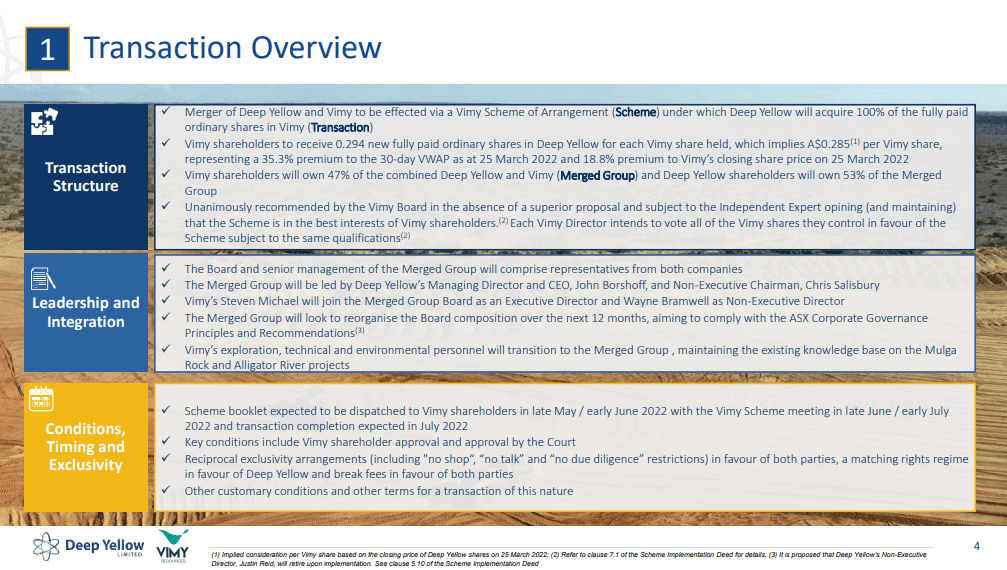
Targets 2022 and Beyond
Deep Yellow is currently focused on the Tumas project, which is advancing as per the schedule and is expected to complete by Q4 2022. The environmental approvals are on schedule and are expected by mid-2022. A DFS has been completed on the project. The company has plans to carry out design engineering, and detailed engineering, which is expected to take about 6 months.
At the Mulga Rock Project, Vimy Resources is looking to revise the DFS in order to include some base metal aspects and exploration. The revised DFS is expected by late 2022 or early 2023.
Interestingly, both the projects are tracking at similar levels, and Deep Yellow plans to spend money on both ends. By mid-2022, the company is looking to acquire sales contracts. This will be followed by an investment decision between Tumas and Mulga Rock. In terms of progress, the projects are 3-6 months apart. The company plans to invest in the project that provides the best value for shareholders. Despite the ongoing environmental regulatory issues at Mulga Rock, the company is confident that it can manage the asset quite well.
The company has a broad vision for its assets and has plans to monetize both projects. It has been chasing an acquisition for the past 3-4 years. This acquisition has also helped the company differentiate itself from the single-asset companies that often have limited opportunities with utilities along with the security of supply issues in recent times. The diversity and security of supply are expected to add significant value to Deep Yellow’s story.

Deep Yellow is not looking at a rushed production. Based on past history and performance, the company is cognizant of its capabilities. The company is currently focused on working out the debt-equity structures. It is looking to acquire bank financing that will potentially attract other shareholders. The company plans to work on each aspect of the capital raise individually over a period of 2-4 months.
Deep Yellow now has the potential to deliver over 6Mlbs in 2 jurisdictions, as a result, it has been approached by multiple utility providers. The company is looking to reach 10Mlbs-15Mlbs production within this decade. The projects have significant potential for equity generation and the company has plans to reserve it as much as possible for shareholder value. The company is open to ideas that would help extend its thrust by helping generate accretive value and getting into production.
The company’s marketing side is developing a strategy on the types and volumes of contracts needed. It is geared towards cementing relationships with real data and information in order to meet the market’s needs.
In order to commence operations, the company would need a myriad of contracts that mesh together in a non-overlapping fashion. Deep Yellow is looking to acquire geographically and nationally diversified contracts. The company understands that building a portfolio of contracts is a slow process and it has been highly intricate in developing these associations. The company is looking to generate value for shareholders that have stuck by the company for a long time.
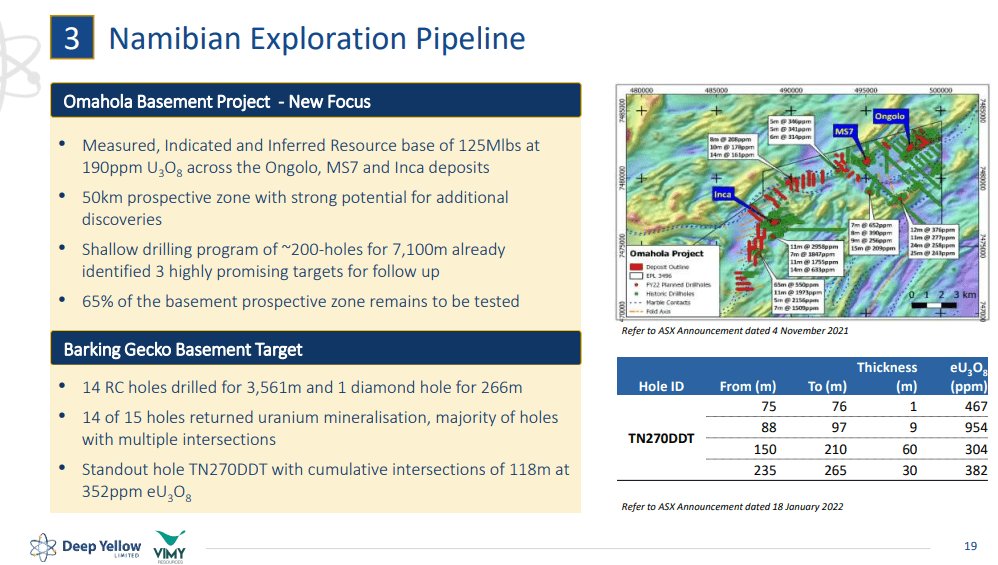
The Uranium Market
According to the company, the over-promising and oversimplifying by utilities has caused immense damage to the market. Companies are looking to make investment decisions based on spot prices. The uranium term price has been static around the $45 mark, which is now bumped up to $50-$55. Deep Yellow anticipates that a $65 spot price would be ideal for a sustainable industry.
Following the Fukushima nuclear disaster in 2011, the uranium industry was brought down to its knees. During this time, utilities went for the cheapest prices, which in turn, adversely affected uranium producers.
While the utilities were complacent with these developments, companies like the SPUT (Sprott Physical Uranium Trust) held the uranium market and took minor inventory out of the system. Deep Yellow anticipates that once other catalysts such as the traditional supply, and reduction in enrichment capacity, the remaining diminished capacity come into play, more uranium will be required for quicker production, leading to a 20% production increase. The company anticipates that this could take anywhere between 3-9 months.
Since more than 20 nuclear reactors have been declared across the world in the past 3 months, the demand for uranium is likely to rise in the coming decades.
Once the utility market comes to grips with the current situation, Deep Yellow will build its project, schedules, and teams. It is seeking an association with a group where it has the assurance that its own product will be used. AS the utilities realise the current situation, Deep Yellow would be open to signing term contracts at mutually agreeable prices. At this time, the company will decide on funding the CapEx (Capital Expenditure) component.
According to the company, a shared responsibility of growth between the shareholder equity and share prices are less dilutive to the shareholder on accretive projects. It helps in balancing out the debt structure through good contracts. The company has plenty of inventory that it can use to capitalise on the upside. Notably, the company is already working on this plan internally. It seeks to have a plan in place before it approaches the market for finance or contracts.
The company will continue to work on its growth strategy for both Deep Yellow and Vimy assets. Deep Yellow’s vision is to obtain growth at Tumas and Mulga Rock. It is looking to become a true tier 1 producer with flexibility and diversity of supply whilst making it attractive to groups beyond a singular idea of selling a product to one utility. Since the next 2-3 years will be formative, the company is running several things in parallel while avoiding any dilution.
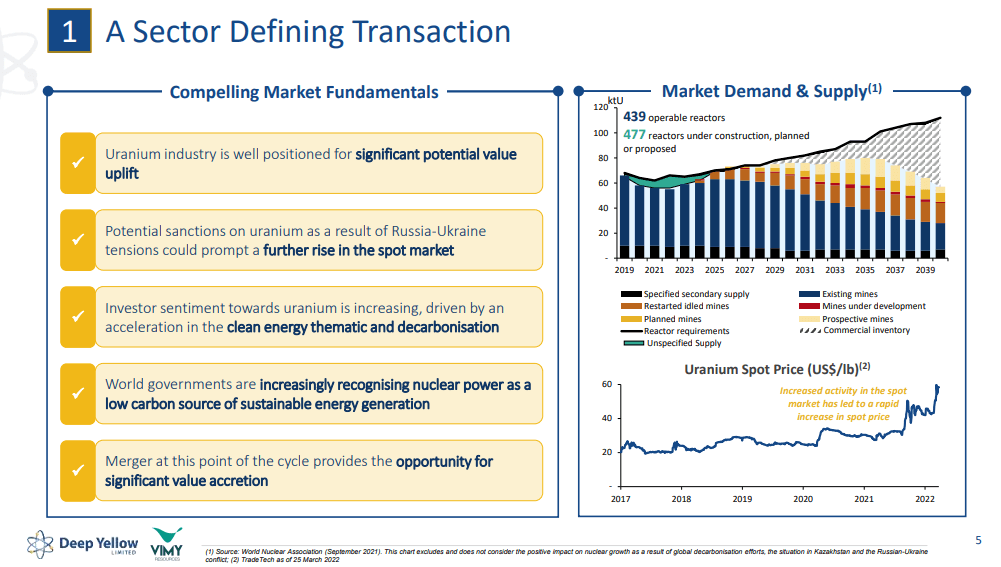
Operational Challenges
Despite challenging government policies in Western Australia, Vimy Resources was successful in getting project approval. This was done with a set of certain operational guidelines. As long as these directives are met, the company can continue to develop the project. At the same time, the company also dealt with environmental issues, indigenous and local issues along with anti-nuclear groups. Interestingly, even though the government isn’t pro-uranium, working within the set framework enables the project to go into development.
Board of Directors
Following the merger, the newly formed company will have 2 Directors from Vimy Resources and 4 Directors from Deep Yellow. One of these would be a NED (Non-Executive Director). Mr. Steven Michaels will be coming in as an Executive Director, ensuring that continuity is not lost in terms of the understanding and appreciation from the government.
According to Deep Yellow, the board needs to grow alongside the company and be open to accepting new challenges. Post-merger, both companies have a 3 month courtship period. During this time, all the legal processes will be carried out. Independent, expert reports will also be generated. During this time, the Vimy shareholders will need convincing that this is a good deal. To get the message across, Deep Yellow is working closely with Mr. Steven Michael, the current Managing Director at Vimy Resources. The process will also include Deep Yellow’s expansion ideas. There will be committees to ensure that support activities happen post-July while ensuring that the 2 companies maintain and respect each other’s confidential information.
Geopolitical Impact
In light of the ongoing Russia-Ukraine crisis, the US is debating whether to completely reject all enriched uranium from Russia. The US might deal with Russia-associated countries, such as Kazakhstan differently. At the same time, China is building a huge infrastructure with the goal of building 45 new nuclear reactors.
Recently, India signed an FTA (Free Trade Agreement) with Australia. This agreement is expected to include normal commodities, along with energy, gas, and uranium. It is important to note that India is also connected to Kazakhstan when it comes to its traditional supply. India, being the third-largest economy in the world is entering this free trade agreement which was announced a few days back. It is important to note that India was working on this agreement for the past 6 months.
Deep Yellow anticipates that the ongoing developments will have lasting changes and have a generational impact. Given the profound changes happening due to recent geopolitical developments, companies operating in the uranium sector need to strategize their vision and determine a way to capitalise on the situation.
There is a need in the market to fill the vacuum left by multi-operational uranium companies such as Rio. These gaps cannot be filled by single-asset companies. Instead, there is a need for companies that can build asset bases that can go out to 2040. Companies need to build for a commodity that has seen an uncertain future in the last few decades.
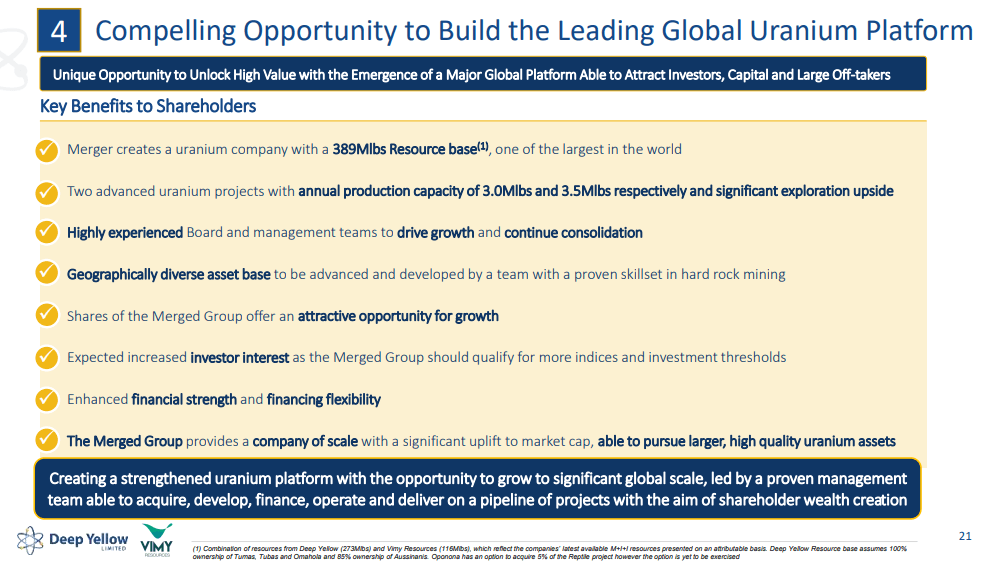
North American vs. Australian Markets
According to Deep Yellow, North American companies are valued significantly higher than their Australian counterparts, in a sense that there is still a crude value, a hidden value in the Australian stocks.
Companies need to balance out the market caps with what they can actually produce. There are companies that fit this category that simply accumulate resources but never enter development. Deep Yellow believes that a uranium developer needs to have an upside that comprises a series of steps in the pipeline. Growth goes beyond the pounds in the ground and achieving a higher share price. By working on multiple fronts, companies can sustain that share price and get accretive value coming through.
Following the merger, Deep Yellow is working on attaining organic growth for the company with real, producing assets. It is looking to build the upside assets such as the Alligator and Omahola by putting out more resources. The company currently has an internal pipeline and strategy that it’s working on. It is important to note that in order for these strategies to be implemented, they need to fit the Deep Yellow growth model.
To find out more, go to the Deep Yellow website
Analyst's Notes




Subscribe to Our Channel
Stay Informed











